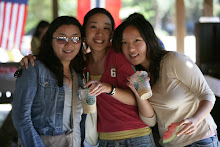This should give something of an idea of not only what Interantionals bring with them to the campus, but how their presence rallys high profile events programing - with that special twist of La Interncional too !

 KICK OFF 2007 WITH BOSTON UNIVERSITY'S SPRING SEMINARS IN FOOD, WINE, AND THE ARTS
KICK OFF 2007 WITH BOSTON UNIVERSITY'S SPRING SEMINARS IN FOOD, WINE, AND THE ARTS Highlights include a master class on Italian wines and a pork cook-off between top Boston chefs
(Boston) – Looking for fun and unique ways to start the New Year? Boston University Metropolitan College’s spring 2007 Seminars in Food, Wine, and the Arts are the perfect way to spend some leisure time. But watch out, you might even learn something.
Offered through MET’s Lifelong Learning program, this special series of seminars is designed to both entertain and educate and includes nearly 40 programs, special events, classes, and day-long excursions. From wine tastings and springtime walking tours of Boston’s culinary neighborhoods to cooking demonstrations by notable chefs like Jacques Pepin, Sara Moulton, and Barbara Lynch, there is something for everyone.
Kids can even learn their way around the kitchen through the program’s series of hands-on cooking classes for children ages 8 – 14. “There is still time to register for any one of our programs or events,” said Rebecca Alssid, director of the Lifelong Learning and Master of Liberal Arts in Gastronomy programs at BU. “Each promises to be an informative, fun, and unique way to spend some leisure time or learn more about the various career options in food, wine, and the arts.”
Highlights of the spring 2007 season include a master class on the great wines of Italy featuring Bill Nesto and Sandy Block – New England’s only resident Masters of Wine; a pork cook-off between some of Boston’s best chefs; an intensive four-day conference on food photography and styling; a food and wine pairing series; and a food and wine writing symposium with Judith Jones, vice president and senior editor at Alfred A. Knopf, who helped launch the career of Julia Child.
Featured events include:Wine and Food Pairing Series at Legal SeafoodsJoin Master of Wine Sandy Block and Executive Chef Rich Vellante for this fun and educational series of classes on pairing fish with wine, held in the exquisite wine cellar at the flagship Park Square Legal Seafoods, surrounded by 16,000 bottles of wine. Rich and Sandy will begin the evenings discussing the food and wine choices, followed by a delicious multi-course dinner that highlights the perfect pairings of wine with fish. $110/class; $400 for the series, includes all food, wine, taxes and gratuities. 6:30 p.m.
Dates: Tuesday, January 23: Red Wine and Fish: Why Not?Tuesday, February 27: Wines of the Loire Valley with FishThursday, March 29: New Zealand Wines and FishTuesday, April 24:
Sparkling Wine and Fish:
The Ultimate Luxury MatchA Taste of EleganceJoin in the fun as some of Boston’s top chefs compete to showcase their creativity and the versatility of cooking with pork. Each chef will offer their best pork dish for you and your friends to try. At the end of the evening, the best chef will win awards for “best pork dish” and “crowd favorite.”
Last year Jason Santos took home top honors — see if he can repeat his “pork-formance!” Live music and a glass of wine are included. Some of the chefs presenting are: Josh Ziskin, La Morra; Kevin Crawley, Coriander Bistro; Carolyn Johnson, Rialto; Marc Orfaly, Pigalle; Jamie Bissonnette, Eastern Standard; Jason Santos, Gargoyles on the Square; Laura Brennan, Caffè Umbra; and others. $40Date: Monday, January 29Time: 6 p.m.
A Master Class with the Masters: Italy’s Great WinesIn collaboration with the Seaport World Trade Center & Seaport Hotel, Bill Nesto and Sandy Block, New England’s only resident Masters of Wine—and expert teachers of wine at Boston University’s Elizabeth Bishop Wine Resource Center—will present a two-day immersion course in the wines of Italy. Attendees will learn about and taste a selection of the highest quality wines from Italy’s many regions.
Lunches and dinners will feature regional wines and cuisines. Classes are held at the Seaport Hotel and World Trade Center. $800 - includes two full-day immersion seminars, all wines, lunches, dinners, and free entrance into the Wine Expo.Dates: February 7 – 8Time: 9 a.m. – 9 p.m.Food and Wine Writing SeminarHave you ever wanted a career in food or wine writing? This one-day conference will cover various aspects of food and wine writing and give you insights from some of the best in the business.
The speakers, who hold a range of positions in the industry, will give presentations and answer all of your questions. The eminent Judith Jones will give the keynote address. Ms. Jones is vice president and senior editor at Alfred A. Knopf, and was responsible for launching the career of Julia Child by fighting for the publication of Mastering the Art of French Cooking. She has worked with many notable chefs, including James Beard, Marion Cunningham, Lydia Bastianich, Marcella Hazan, Madhur Jaffrey, Edna Lewis, Jacques Pepin, and Claudia Roden, as well as non-chefs such as Anne Tyler and John Updike. Date: Saturday, March 31Time: 10 a..m – 4:30 p.m.
The International Conference of Food Photography and Styling: A World View of Business, Techniques, and DesignThis intensive four-day conference is sponsored by the Master of Liberal Arts in Gastronomy at Boston University and chaired by Lisa Golden Schroeder and John Carafoli, international food stylists, writers, and culinary consultants.
John Carafoli is the author of Food Photography and Styling and Lisa Golden Schroeder is the founder of Foodesigns.com, an online resource for professional food stylists and photographers. With a strong emphasis on creative thinking for food photography professionals, this conference focuses on the business of creating compelling food images for effective visual food communications, featuring panel presentations from leading international food stylists, photographers, and design professionals; styling and photographic technique demonstrations; and interactive discussions of important issues facing both food photography professionals and those that commission their work—from food corporations to cookbook and magazine publishers.
Insightful advice on small business marketing and promotions for both photographers and stylists will be on the program. For more information, call 617-353-9852. Dates: June 1 – 4As one of the 17 degree-granting bodies that comprise Boston University, Metropolitan College (MET) offers part-time, full-time and international students a remarkable range of choices for study to enrich their lives and advance their careers. MET offers undergraduate and graduate degrees, diploma and certificate programs.
Founded in 1839, Boston University is an internationally recognized institution of higher education and research. With more than 30,000 students, it is the fourth largest independent university in the United States. BU contains 17 colleges and schools along with a number of multi-disciplinary centers and institutes which are central to the school’s research and teaching mission.








